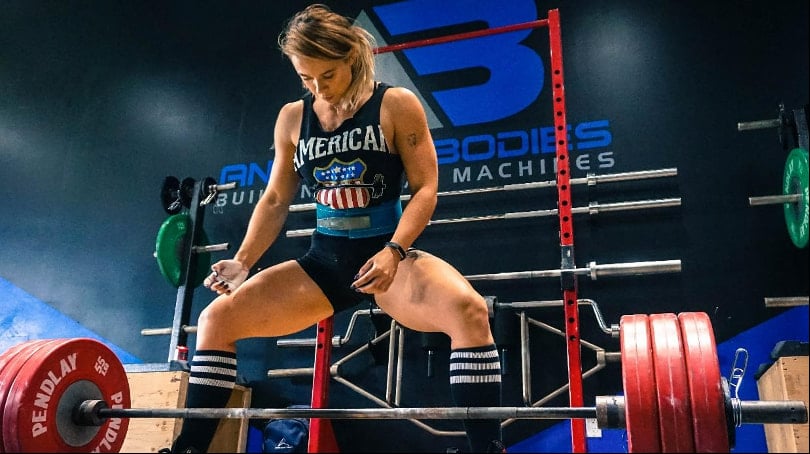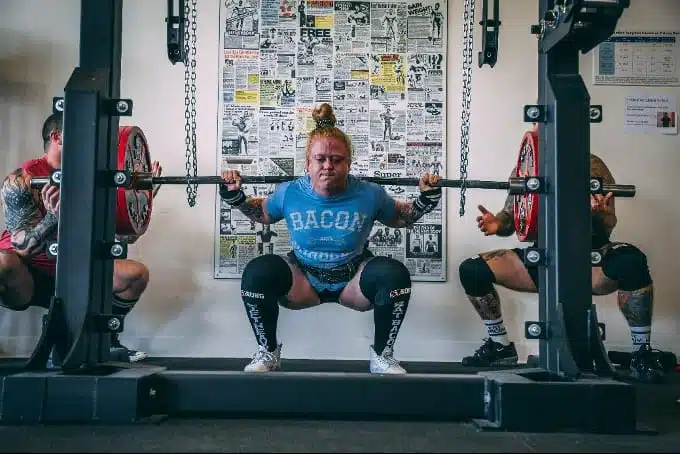12 de May de 2023
All About Max Effort Training
Max Effort Training – What is it?
Louie Simmons was an American weightlifter and strength coach. One of the most important pieces of his legacy was the “conjugate method”. The creator of Westside Barbell, he gathered all his learnings as an athlete and as a coach for his athletes to obtain maximum performance based on his methods. Simmons has authored several books whose common characteristics are the three types of training of the conjugated method: maximal effort, dynamic effort and repeated effort or repetition (Simmons, 2007, 2022).
Maximal effort training is one of the basic pillars to improve the maximal strength of athletes, but it must be complemented with dynamic effort training and repetition or repetition effort. The three methods serve to improve the different manifestations of strength, and it is recommended to use them in greater or lesser volume depending on what our objective is.

What’s The Intensity of Max Effort Training?
Maximal effort training requires maximal or submaximal loads, above 90% of 1RM (Zatsiorsky & Kraemer, 2006). The goal of maximal effort training is to lift the maximum possible load without giving special importance to the speed at which we move the bar. An athlete will have to impart maximum acceleration to the bar when he has that much load if he wants the lift to be successful, even if the velocity from strength looks slow, even at times close to zero.
In the strength-velocity curve, maximal effort training seeks to improve maximal strength, and not so much the speed part (Alcazar et al., 2019). To improve that part of speed in the strength-speed curve we will have to work with lighter loads and higher speed. This type of training is what is known as dynamic effort. Maximum effort and dynamic effort training complement each other perfectly, as the former increases our ability to move weight, and the latter seeks to transfer those gains to sports disciplines that require applying maximum force in the minimum possible time(Sugi & Ohno, 2019).
Max Effort Training & Dynamic Effort Training Differences
The main difference between the maximal and dynamic effort training method is the load we lift. The former method requires high loads, from 90% of 1RM upwards, while the dynamic effort method has a much wider range of loads that can go from 40% to 80% of 1RM. The load indirectly produces the second difference between the two methods: the speed of the lift.
As we add load to the bar, the velocity at which we can move the bar becomes slower (Sanchez-Medina & Gonzalez-Badillo, 2011). You can easily check this by performing a squat with an empty bar and adding more load to the bar. The exercises used in both methods are similar and even the same, since they are basic exercises such as squat, deadlift, bench press, rowing, etc., as well as their variants.
Is Max Effort Training Useful?

Maximal effort training is useful for being able to move higher and higher loads, whether your sport is purely maximal strength, such as powerlifting, strongman or weightlifting, or to transfer that maximal strength to your sport discipline. A boxer doesn’t need to bench press 330 lbs., but if they are able to do it, and then use the dynamic effort appropriately, he will be able to throw a much more successful ‘straight’.
Improve Mental & Technical Capacity When Lifting Heavy Loads
Maximum effort training is an ultimate test for our mind to adapt to lifting heavy loads. You don’t know what it feels like to look at a 400 lb. loaded barbell (or your max load) waiting to be lifted in a squat exercise, until you do the exercise. Facing that load repeatedly makes it normal, and makes you lose fear. By doing the exercise at such a slow speed, our body prepares itself to fight each repetition and not give up.
The technique of an exercise can be perfect if we do it without load or with a wooden stick, but when it really shows if the technique is good or not, is when we are subjected to a high load. Maximum effort training is a method to polish our technique with maximum or near maximum intensities. To get there, it will first be necessary to have a technique without mistakes, since a mistake with so many kilos on the bar can lead to injury.
Neural Connection Becomes More Effective
Maximal effort training improves the neural connection between muscle and nervous system (Santos et al., 2021). When moving low loads, motor units are recruited as fatigue sets in, and we need to involve more fibers to keep moving the weight. However, if we face a series of incredibly low repetitions, or one repetition, this recruitment has to occur quickly and in a coordinated manner.
The maximal effort training method produces an adaptation in which the speed of activation of motor units is faster, and more muscle fibers are recruited faster (Herda, 2022). This adaptation will be vital to move heavy loads, and will be the one that is then transferred when we want to apply maximum force in the minimum possible time, as occurs in a jump to finish off in volleyball, or make a dunk in basketball.
Easier Sub-Max Loads When Higher Max Loads
Who will have a harder time carrying their heavy suitcase up the stairs? Someone with a dead weight of 225 kg or a person with a dead weight of 120 kg? The greater our maximal strength, the easier we will move submaximal loads. Maximum effort training allows us to gain maximal strength, and that will positively affect game throws such as contesting a split ball in soccer or tackling an opponent. Depending on the demands of our sport
The well-known coach Eric Cressey has a phrase that says that in a bigger cup you can fit more things (Cressey & Fitzgerald, 2008). This is an analogy with respect to maximal strength (the glass), since if we increase it (make the glass bigger), we will have more room to improve different manifestations of strength such as power, which is nothing more than the ability to apply force in a short time. Maximal effort training will make us gain more maximal strength, or what is the same, it will make the vessel bigger.
Max Effort Training – When & How

Louie Simmons’ Westside Barbell protocol proposes two or three maximal effort workouts per week (Simmons, 2007). The rest of the week uses dynamic effort workouts and repetition work aimed at muscle hypertrophy. The variation of the basic movements (squat, deadlift and bench press) is modified as the athlete adapts. The volume used in this method is low, but the intensity is maximum.
Depending on the type of periodization used, there will be blocks of maximal effort with a greater load of this type of work, or they can be undulating on a daily or weekly basis. The method of maximum effort is usually placed before blocks of maximum effort, or as peak weeks, called peak week, in which the volume is reduced to a minimum, but high loads are maintained for competition.
Contrary to what it may seem, maximal effort training will not produce delayed onset muscle soreness (DOMS). That DOMS is much greater in typical hypertrophy work, where we bring each set close to muscle failure and are under tension for a long time (Schoenfeld, 2012). If the volume and load used are well controlled, we can even train one movement at maximal effort each day.
Factors to Consider When Using Max Effort Training
Maximal effort training can damage our central nervous system if we overdo it in intensity or volume. Movements with loads above 90% require total concentration, and we should limit sets close to 100% of 1RM, and stay away from muscle failure in the others. A set of two repetitions at 90% of 1RM is tremendously different from the same set, but doing one repetition instead of two.
Maximal effort involves certain risks that must be assumed when training. The risk of injury increases as we approach our 100% 1RM or evaluate a record weight. Under no circumstances should this method of maximal effort be performed on novice strength athletes who do not have perfect technique.
Max Effort Training With a VBT Device

Maximum effort training uses high loads, 90% or more, so we must control intensity and fatigue very well. The sets close to our maximal lifting are highly demanding, and the role of the coach is essential when programming the sessions. The number of sets, as well as the decision to conduct a maximal effort training day or not, depends on the athlete’s fatigue.
VBT devices are the most reliable, affordable and quickest tool that athletes currently have to know the degree of fatigue of our athlete, both at the beginning of the session, as well as throughout the session (Zhang et al., 2022). Something as simple and quick as a vertical jump will indicate to the coach if the athlete is fatigued, so he/she will have to modify the session, since in order to conduct a maximal effort training the athlete must be fully recovered from previous sessions (Watkins et al., 2017). By measuring the height of the vertical jump, the application of our Vitruve device shows us the take-off speed.
Thanks to certain mathematical formulas, we will know variables such as take-off speed, height, etc., and we can compare them with their normal parameters. If it is within these parameters, the athlete is recovered, but if the jump has a lower take-off speed and height than the athlete is used to, it is because there is fatigue in that musculature, and we cannot train with maximum efforts for the lower body.
The same is true for all types of movements such as pull-ups, bench presses, and any basic exercise. Bar’s velocity can be easily obtained by connecting the cable of the speed measuring device to the bar, and executing a repetition at maximum speed. This tool can be used at the end of the warm-up, and is tremendously useful to know the state in which the athlete arrives at training.
In turn, a certain speed loss can be planned between sets. The greater the loss of speed, the more fatigue the athlete will accumulate (Zhang et al., 2023). Imagine that in today’s session we want the athlete to work at 90% of his 1RM. When he does the first repetition of the first set, the speed at which he moves the barbell will be the fastest and we will take it as a guide. Let’s assume that he moves the load at 0.30 m/s.
Based on this, we will be able to program the number of sets of the day in an open way, stopping the training when that first repetition of a set is, for example, 10% slower. This means that our device will alert us when the athlete lifts at less than 0.27 m/s, which is the result obtained when 10% of speed is lost with respect to the fastest repetition we take as a guide, in this case 0.30 m/s. In this way, we will not program a fixed number of sets, for example four sets of two repetitions, but we will ask the athlete to do sets of two repetitions until he loses 10% of speed in this case. It could be two sets, or it could be six. It will be the programmed speed loss that tells us.
Joaquín Vico Plaza
References
Alcazar, J., Csapo, R., Ara, I., & Alegre, L. M. (2019). On the Shape of the Force-Velocity Relationship in Skeletal Muscles: The Linear, the Hyperbolic, and the Double-Hyperbolic. Frontiers in Physiology, 10(JUN). https://doi.org/10.3389/FPHYS.2019.00769
Cressey, Eric., & Fitzgerald, Matt. (2008). Maximum strength : get your strongest body in 16 weeks with the ultimate weight-training program. 227. https://www.buscalibre.es/amp/libro-maximum-strengthget-your-strongest-body-in-16-weeks-with-the-ultimate-weight-training-program/9781600940576/p/1960136
Herda, T. J. (2022). Resistance exercise training and the motor unit. European Journal of Applied Physiology, 122(9), 2019–2035. https://doi.org/10.1007/S00421-022-04983-7
Sánchez-Medina, L., & González-Badillo, J. J. (2011). Velocity loss as an indicator of neuromuscular fatigue during resistance training. Medicine and Science in Sports and Exercise, 43(9), 1725–1734. https://doi.org/10.1249/MSS.0B013E318213F880
Santos, P. D. G., Vaz, J. R., Correia, P. F., Valamatos, M. J., Veloso, A. P., & Pezarat-Correia, P. (2021). Intermuscular Coordination in the Power Clean Exercise: Comparison between Olympic Weightlifters and Untrained Individuals-A Preliminary Study. Sensors (Basel, Switzerland), 21(5), 1–16. https://doi.org/10.3390/S21051904
Schoenfeld, B. J. (2012). Does exercise-induced muscle damage play a role in skeletal muscle hypertrophy? Journal of Strength and Conditioning Research, 26(5), 1441–1453. https://doi.org/10.1519/JSC.0B013E31824F207E
Simmons, L. (2007). The Westside Barbell Book of Methods. Power.
Simmons, L. (1947-2022). (n.d.). The conjugate method : enhanced through the research of Westside Barbell.
Sugi, H., & Ohno, T. (2019). Physiological Significance of the Force-Velocity Relation in Skeletal Muscle and Muscle Fibers. International Journal of Molecular Sciences, 20(12). https://doi.org/10.3390/IJMS20123075
Watkins, C. M., Barillas, S. R., Wong, M. A., Archer, D. C., Dobbs, I. J., Lockie, R. G., Coburn, J. W., Tran, T. T., & Brown, L. E. (2017). Determination of Vertical Jump as a Measure of Neuromuscular Readiness and Fatigue. Journal of Strength and Conditioning Research, 31(12), 3305–3310. https://doi.org/10.1519/JSC.0000000000002231
Zatsiorsky, V. M., & Kraemer, W. J. (2006). Science and practice of strength training. 251.
Zhang, X., Feng, S., & Li, H. (2023). The Effect of Velocity Loss on Strength Development and Related Training Efficiency: A Dose-Response Meta-Analysis. Healthcare (Basel, Switzerland), 11(3). https://doi.org/10.3390/HEALTHCARE11030337
Zhang, X., Feng, S., Peng, R., & Li, H. (2022). The Role of Velocity-Based Training (VBT) in Enhancing Athletic Performance in Trained Individuals: A Meta-Analysis of Controlled Trials. International Journal of Environmental Research and Public Health, 19(15). https://doi.org/10.3390/IJERPH19159252

